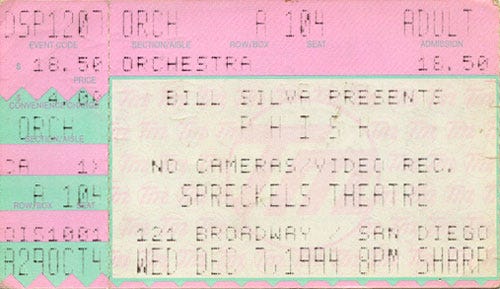
There are four pillars holding up the superstructure of A Live One: Stash, You Enjoy Myself, Tweezer, and Harry Hood. Well duh, they are the four longest tracks, but — with apologies to Coil and Slave — they are also the songs that make the boldest statement about what Phish could do when they were gathering string for their breakthrough double-disc. This date in 1994 brings us the YEM we know and love, the latest-recorded piece of that quartet, and in many ways the least significant, even if it happens to be probably the defining song of the entire Phish catalog.
The A Live One You Enjoy Myself comes from a pretty unassuming and unusual show. Spreckels Theatre in San Diego is the smallest venue of fall tour, at only 1360 capacity, and probably one of the tiniest rooms they played all year. Despite the intimate setting and the contribution of a famous YEM, this show is smeared with the second-lowest Phish.net rating of the entire fall itinerary, only topping Chattanooga way back in on 10/16. That’s not very fair, as I’d definitely rank it above the sleepy Sunday show a couple essays back; it’s got a decent first set, though the second set probably submarines its reputation by neither choosing a jam vehicle nor an emotional lane.
And at the very end of that uneven second set comes the first You Enjoy Myself that many people, including myself, would ever hear. It’s a weird pick, especially given the selection criteria for A Live One that Trey laid out in The Phish Book:
“Rather than representing the best music we make during a particular era, our live albums seem to document transitional moments. So A Live One has the Bangor Tweezer and the Great Woods Stash, which is the oldest thing on the album. Other Stashs might have been better, but that’s the one we really took over the top in that kind of frantic way we were playing back then.”
While each very different, the ALO Stash, Tweezer, and Hood all couldn’t have been played before 1994. But that standard doesn’t apply to this YEM, which is anonymous enough that it could slot into any early 90s show, apart from Trey getting briefly digital-delay-loopy at the end of the jam. No, this particular YEM appears to have been chosen not because of a stylistic breakthrough, but simply because it was the cleanest contender in its class.
Which is no faint praise. Playing a flawless YEM is a little like pitching a no-hitter; the whole team has to sustain excellence over a lengthy chunk of time, with zero tolerance for mistakes or bad luck. The Spreckels YEM does a great job of recreating the song as it exists on paper, or at least on Junta — in fact, it’s quite a bit faster than its studio version. All the composed parts and fills and Notes are executed near-perfectly, and there’s only one significant error: Page coming in a bar early on the pre-BoyManGodShit scream, the squib single that turns a historic perfect game into a respectable complete game shutout. Even the vocal jam is on the tolerable end of the spectrum, with some interesting rhythmic and melodic ideas instead of just pure howling. That complete package is a godsend, given that Phish admirably chose to eschew overdubs and splicing on A Live One.
This YEM is also the “cleanest” of the tour in terms of approachability for the new fans they hoped A Live One would attract — a funny thing to say for a 21-minute song, but that’s Phish. Pretty much all of the other serious YEM candidates from Fall 94 had some very Phishy business going on, such as The Vibration of Life or Catapult, teases of the highly-unfashionable-for-the-time Edgar Winter Group, Queen, or Classics IV, or a vocal jam that ends with them scream-chanting “GREENPEACE MIKE!” Those inside jokes might work in the moment for a paying audience, but less so for posterity, or for a listener encountering Phish for the first time.

So the image that the A Live One YEM projects is not so much a transition, but competence. Here’s how fast and immaculately we now play this incredibly knotty composition from our debut album, and how we’ve successfully fleshed it out with a funk jam, a bass-and-drums duet, and several minutes of us doing collective beat-boxing vocal jazz — er, it’s better than it sounds, trust us. They wagered that a replacement-level YEM was compellingly weird enough to entice new listeners in 1995, and anecdotally, I can tell you that I was definitely into it.
They couldn’t have known that You Enjoy Myself was about to take its own big leap forward in the six months after A Live One came out; that’s just the risk of capturing a moment in time from a band that’s always on the move. And they couldn’t very well release an album purporting to be the definitive live document of mid-90s Phish without a YEM. The San Diego performance does the job with dignity and grace, even if it’s jamchart entry was destined to merely, plainly say “Version that's on A Live One.”
[Stub from Golgi Project.]
